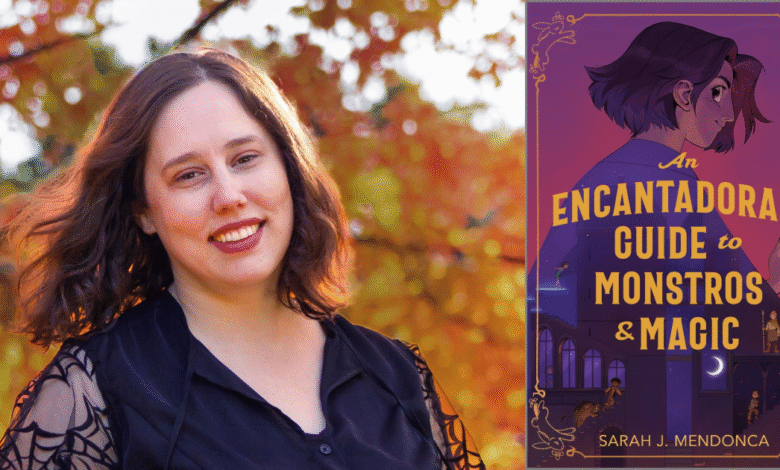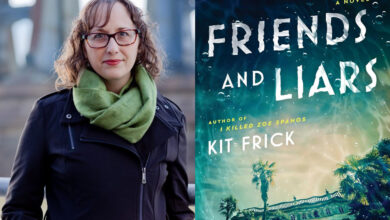Indies Introduce Q&A with Sarah J. Mendonca

Sarah J. Mendonca is the author of An Encantadora’s Guide to Monstros and Magic, a Summer/Fall 2025 Indies Introduce selection.
Nicole Johnson of Baltimore Read Aloud in Baltimore, Maryland, served on the panel that selected Mendonca’s book for Indies Introduce.
“What would you do to preserve your family traditions and livelihood?” said Johnson. “Rosa Coelho leads a band of magical misfits on a journey to reclaim what the wealthy have taken from her friends and family. Along the way, they face monsters and plan a heist. This story invites you on a whirlwind adventure.”
Mendonca sat down with Johnson to discuss her debut title. This is a transcript of their discussion. You can listen to the interview on the ABA podcast, BookEd.
Nicole Johnson: Hello, everyone! My name is Nicole Johnson. I am with Baltimore Read Aloud, a mobile and pop-up book shop based in Baltimore City.
I’m really excited today to be here with Sarah J. Mendonca. She is a Portuguese-American author of magical books about misfits finding their own way in the world. Sarah lives in Wisconsin, and you can find her haunting dark forests, lurking in bookshops, and buried underneath her enormous tea collection.
We are so excited because her debut novel An Encantadora’s Guide to Monstros and Magic was selected as an Indies [Introduce] pick. We are going to dive into a conversation, learn a little bit more about Sarah, and get the inside scoop about this amazing middle grade novel.
So Sarah, first tell us first a little bit about yourself. How did your journey as a writer begin?
Sarah J. Mendonca: Thank you for the question. I had a bit of a longer journey than the average author. I started writing when I was a senior in high school and I’d never written a short story before. For better or worse, I [went] right into a full-length novel, which took me four years. Through that experience, I learned that I’ve got the grit to finish anything I set my mind to and I knew that one day I’d get a book published, and though it ended up taking fifteen years, I made it by not giving up. My journey is definitely one of persistence and resilience in the face of rejection.
NJ: How did you get introduced to fantasy and magic? What drew you to that genre?
SJM: As a kid I was a bit of a misfit and I used to spend my recess reading under the trees instead of playing. I loved fantasy books because they showed me a world where I felt like I belonged, and my goal as an author has always been to give kids that same feeling of belonging. I want them to feel seen and [to] find a place of comfort in my books, so I find that fantasy really suits who I am as a person.
NJ: When you think about fantasy and magic, do you have any favorites in terms of books that you’ve read or movies that you’ve seen?
SJM: I have many favorites, but I would say my big two influences are Tamora Pierce and Garth Nix. [For] Tamora, her books had these really strong female protagonists who were overcoming huge odds. I actually have art behind me right now of Keladry of Mindelan, from her Protector of the Small series. This is actually one of the few series where she doesn’t have a magical character. This character is going against monsters the entire series, she’s a female knight, and she’s the second female knight to join the knighthood, and she has to overcome a lot of experiences of sexism and harassment [and] overcome the odds of people telling her that she’s weak.
I actually had a really bad fear of heights, and this character has a bad fear of heights so I learned a lot from them. I actually did a bunch of adventure races where I would climb twenty-foot walls and jump over fire and [it] just help[ed] me with my fear of heights. This just shows how powerful books can be, where you can see who you want to become on the page, and it can really inspire you to become that [and] to face your fears.
NJ: Yeah! As you were describing that, I can hear elements of Rosa, the main character in An Encantadora’s Guide to Monstros and Magic, in what you were describing from your favorite books. Rosa is a strong protagonist [but] she’s getting mixed messages about her ability and it influences her confidence. She definitely has a strong family, with her grandmother, but she also has this found family as the story evolves.
Lead us into your novel: tell us a little bit about what it’s about, and what your inspiration was as you were developing Rosa and this group of magical misfits that are trying to solve this heist throughout the story.
SJM: I was very inspired by Encanto meets a younger Six of Crows. I started working on that story when I had just moved to a new town, I was feeling a longing for my family. At that time, I stumbled upon Six of Crows, which is a magical heist, and that book really connected with me on a deep level. I loved seeing all of these characters supporting each other — this found criminal family. Those two things really connected with me.
I have this very Portuguese-influenced world and I really wanted to showcase that [while] mixing it with heist. I love heists so much. They’re absolutely one of my favorite genres to consume. When I was researching this book, I was watching lots of heist movies, [such as] Ocean’s Eleven and then The Bad Guys. I think the best part of heists is that you have all these specific characters, these character archetypes, you get to play with. You have the mastermind; you have the pickpocket.
Once I figured out (because I like to make things hard for myself) that I wanted the magical lock pick to be the main character, I built the crew around her. Rosa is very smart, but she’s very stubborn. This whole story is about how she’s struggling to connect with others and form those friendships. I wanted to create people that would add a lot of heart to the story, a lot of humor. What’s been really interesting is hearing from early readers who their favorite characters are. Some really love Tiago, the pickpocket, who’s very funny, but then some people love Jacinto, the very grumpy book forger. That has been very interesting, because I thought that certain people would easily be the favorites, and it’s been lovely seeing people connect with the different characters.
NJ: There’s such a range and diversity of both their roles within the heist team, and the nature of who they are as individual characters — some more confident than others, some more caring than others, some more honest than others. There’s a really nice balance in the group of folks that come together as a part of the heist.
One of the things that I found interesting about your story is that there’s the coming together of the young people to be a part of this and take part in this heist, but there [are] also underlying elements where they’re battling against the ministry that governs magic and sets up parameters and taxes that have very oppressive implications for them as individuals, and on their magic skills, but also on their families.
Could you talk a little bit about how you brought together the ideas and elements of the magical heist with this backdrop of the ministry and those more social commentary pieces within the story?
SJM: I knew that I wanted Rosa, the main character, to grow up in poverty. Both my parents grew up in poverty, and I’ve seen the impacts it’s had on their lives. As I was thinking about this, I was really realizing that poverty can be a trap. The main character is a monster trapper, but poverty itself (…) you can be stuck in it. There can be all of these systems that are working against you, that trap you there, [and] that’s not very fair.
In our modern system right now, half of Americans only have $400 in savings. They are near the edge of disaster, and it’s not their fault. It’s all based on luck. Who gets lucky? In this story, who has their debts called on or who accidentally gets bitten by a monstro? There’s a lot of people who live on the edge and it’s not fair. I really wanted to showcase the unfairness of it and the systematic nature of it — that it’s not these characters faults, it’s the systems they live under.
NJ: You do it in a way that doesn’t blame or dismiss; there’s a lot of heart in the way the characters both react to the unfortunate situations that emerge, but also [enact] their sense of agency. There is something that they can do about it.
I know you were just at Children’s Institute, and you were excited because, if I’m not mistaken, you saw the book just before Children’s, so we were all really excited for you. Now it’s out in the world, and you’re starting to hear that feedback as it releases to the general public. What are you hoping kids and educators and parents and families really get from your book?
SJM: There sometimes can be this hopelessness with the hardships that are going on in the world right now, and I love middle grade because it always finds hope in the darkness and it lights that candle.
There’s a point in the book where the characters find [out] something quite upsetting, and they feel that hopelessness that the odds are stacked against them, that they can’t do anything. One of the characters says, “I don’t know if we can do anything, but we can do this one action, we can move this one stone, and that might cause the avalanche of change.”
I want people to feel that.
It might feel hopeless on a large, world scale, but putting a book in a Little Free Library and having one person connect with that story and feel less hopeless, being kind to those around you…there’s small, everyday actions that we can take to make the world a better place, even when there’s big, systematic things happening. We can work on our own scale, on our own level, even if it’s within our own household or friendship group.
NJ: Thank you. For me, that’s something that I’m always looking for in middle grade titles, this sense of the adventure and the community that comes with the book, but also giving young people examples of how they can take action and ways that they can begin to address what’s going on, not in the world, but also in their everyday lives. There’s something that they can do to make a change.
So, what can we expect from Book Two?
SJM: I’m working on Book Two right now, and currently, it’s a duology. Right now, I’m trying to address what happens in Book One and continue [that] into Book Two. I don’t want to give too much away, but I’m going to say that there’s a lot of heart, and we might be getting a smaller, furrier, new member of the crew in the form of an adorable puppy.
NJ: I was like “Oh, is this gonna be a good monster that comes along and helps or that becomes a little pet for the crew?” A puppy sounds cute too. That’s gonna be fun.
Well Sarah, thank you much for talking with me today. Folks, Sarah’s book will be out on July 8. Please do all that you can to handsell it, and bring Sarah around into your stores [so] she can do visits and connect with schools and students. Thank you much, Sarah. It’s been a pleasure talking with you.
SJM: Thank you so much.
An Encantadora’s Guide to Monstros and Magic by Sarah J. Mendonca (Quill Tree Books, 9781335012883, Hardcover, Middle Grade Fantasy, $19.99, On Sale: 7/8/2025)
Source link



